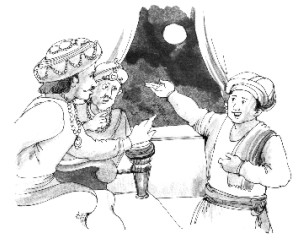Story
Truth Related to Reality
 Kashi, which is a holy city on the banks of River Ganges in India, was once the capital of a state ruled by an eminent king. His court consisted of a galaxy of great scholars, whose deliberations evolved “In search of truth” and this motto was also prominently displayed in golden letters. Kashi, which is a holy city on the banks of River Ganges in India, was once the capital of a state ruled by an eminent king. His court consisted of a galaxy of great scholars, whose deliberations evolved “In search of truth” and this motto was also prominently displayed in golden letters.
One fine morning, a young monk, entered the court and suggested a change in the motto, to “In search of reality” to the surprise and amusement of the assembled scholars.
“Truth need not be the same as reality declared the young monk, to a shocked audience. Truth is what you believe in, but reality is what is”. To demonstrate his statement he caused many barrels of oils to be placed in an open area, on a full moon night, when the moon was clearly reflected in their oily surfaces.
“My dear friends” said the young monk, “the moon in the oil barrels is a truthful reflection and you may believe them to be as many moons as the barrels if you don't look up to the moon above but you are also aware of the reality of a single moon.
Similarly you may create any number of wooden articles and call them by different names, but you are aware of the basic reality of wood in them. When the barrels are emptied of oil, these truthful reflections disappear but not
the real moon.
When the different items of furniture are broken, they lose their individual names, but become only scraps of wood. What we believe is normally conditioned by space and time, but the reality is beyond them.
Hence our efforts should be directed “In search of reality” and the motto should be that also.
The entire assembly found that there was sense in his statements and power in his advocacy, and so the motto was modified as “In search of reality”.
After a few years the galaxy of scholars again received a shock, when another young monk demanded a change in the motto, saying that it should be “In search of truth and reality”.
“My dears”, declared he to the confused audience, “truth may not be the reality. It also has its place in the scheme of things. While you see the numerous truthful reflections of the moon in the oil barrels, you cannot ignore their existence, though you accept the reality of one moon.
Similarly you cannot ignore the varieties of furniture, with their different names, as long as they exist. All of you are in reality, men and women, but no one can ignore the fact, that each one of you have an individual name. The sum total of truth may be called reality, but even reality could be broken down to many individual truths”.
“Hence, I suggest”, he advised the now convinced assembly, “that the motto be redrafted to read, 'In search of truth and reality'”. Everyone applauded, agreed and accepted the change. But not for long after a few years, another young monk appeared on the horizon, to contest the wording of the motto.
“How can you say that a truth is truthful unless it is in some way related to reality”, he now challenged the astonished scholars. “All the reflections of the moon in the oil barrels, receive their source from one reality and they are connected to it. Without the moon, there can be no reflections.
Similarly, all the wooden furniture are related to one source, the wood. You have to concede that, truth in whatever form, is ultimately related to reality. Hence all your declarations would become meaningful, when you go in search of “Truth related to Reality”.
All the scholars realised the realistic truth in his statements, and so it came to pass that the matter was again changed as per his wishes.
This story reveals the innate inter-link among the three schools of thought in Indian Tradition, “Advaitha” non-duality, “Dwaitha” duality and “Vishisthadwaitha” duality reflecting non-duality.
Copyright
(R) thedailystar.net 2008
|
